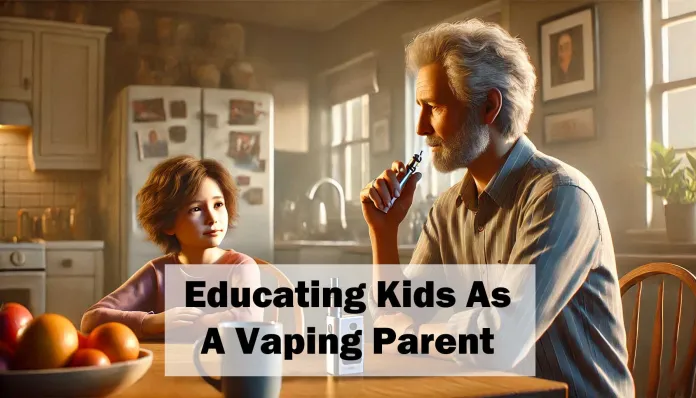
It happens unexpectedly. You’re going about your day when your child suddenly asks, “Mum, Dad… why do you vape if it’s bad for you?”
For a moment, you freeze. You knew this question would come eventually, but that doesn’t make it any easier. You feel the weight of their curiosity, their need for an answer that makes sense. You could brush it off with a quick response—“It’s not something for kids”—but deep down, you know that won’t be enough.
As a parent who vapes, you face a unique challenge. You want to educate your child about the risks of vaping, ensuring they make informed decisions, but at the same time, you don’t want to feel like a hypocrite. Maybe you started vaping as a way to quit smoking, or perhaps it was a choice for other personal reasons. Either way, your child looks up to you, and what you do matters as much as what you say.
This guide will help you confidently navigate the conversation, balancing honesty, education, and responsibility. It will explore how to talk to your child about vaping, manage your own habits in a way that doesn’t encourage them to follow suit and handle guilt or shame that may arise. The goal is not to be a perfect parent but to be informed—someone who can guide their child with wisdom, honesty, and a strong sense of responsibility.
Understanding Why Kids Are Drawn to Vaping

Before you can educate your child about vaping, it’s essential to understand why young people are so easily drawn to it. Vaping is often marketed as a trendy, harmless, and socially acceptable habit, and young people are more susceptible to these influences than adults.
1. Peer Pressure and Social Influence
Picture this: your child is at school, and during lunch, a group of their friends pulls out sleek, brightly coloured vapes. Someone takes a puff and laughs, saying, “It’s just flavour—it’s not like smoking.”
Peer pressure is one of the most powerful reasons young people start vaping. They don’t want to feel left out; if everyone else is doing it, the fear of missing out (FOMO) becomes overwhelming. Unlike smoking, which often carries a stigma, vaping is seen as a modern, socially acceptable habit, making it even harder for kids to resist.
2. Flavours and Marketing Appeal
Many young people don’t start vaping because of nicotine; they start because of the flavours. Fruity, sweet, and dessert-inspired e-liquids—such as strawberry lemonade, blue raspberry, and cotton candy—appeal to younger audiences.
But it’s not just the flavours. Vape companies use social media influencers, bright packaging, and sleek designs to make vaping seem stylish and desirable. Platforms like TikTok and Instagram are full of content normalising vaping, often portraying it as cool, harmless, and rebellious.
3. Perceived Safety and Misinformation
Many teenagers genuinely believe that vaping is harmless or much safer than smoking. While vaping does eliminate many of the harmful chemicals found in cigarettes, it still exposes users to nicotine addiction and respiratory risks.
Without proper education, many young people fall into the trap of thinking vaping carries no real consequences.
Understanding these influences helps parents better prepare for conversations with their children, equipping them with facts, awareness, and strategies to counteract misinformation.
How to Talk to Your Kids About Vaping

1. Choose the Right Moment
Bringing up vaping out of the blue can feel forced. Instead, wait for a natural opportunity—perhaps when a vaping advert appears on TV, when you pass a vape shop, or if your child mentions that a friend vapes.
Choosing a calm, non-confrontational moment makes having an open, honest conversation easier without feeling like a lecture.
2. Encourage Honest Discussion, Not a Lecture
If your child feels like they are being talked down to, they may tune out or become defensive. Instead of giving a lecture, engage them in a two-way conversation:
Parent: “I know you’ve probably seen a lot of people vaping. What have you heard about it?”
Child: “That it’s not really smoking. Some people say it’s just water vapour.”
Parent: “That’s a common belief, but actually, vape aerosol contains more than just water. It has nicotine, chemicals, and tiny particles that can damage the lungs. It’s not harmless, even if it looks like it.”
You encourage your child to think critically rather than simply absorb information by asking questions.
3. Address the “But You Vape” Dilemma
At some point, your child will ask, “If vaping is bad, why do you do it?”
This is where many parents struggle. The key is to be honest without making vaping seem appealing.
You might say:
“I started vaping because I used to smoke, and it helped me quit. But if I could go back, I wouldn’t have started smoking in the first place. Nicotine is addictive, and even though vaping is less harmful than smoking, it’s not risk-free. I don’t want you to go through what I did.”
This approach is truthful and responsible and reinforces that vaping is not something to take lightly.
4. Make the Risks Clear Without Fear-Mongering
Scare tactics don’t work. Instead of saying, “If you vape, you’ll destroy your lungs,” focus on real, relatable risks:
Vaping affects lung development in young people, making breathing harder over time.
Nicotine changes brain chemistry—making it harder to focus and increasing anxiety levels.
Many young people who start vaping end up becoming smokers later in life.
The goal is to educate, not terrify. Children who understand the science are less likely to fall for misinformation.
How & When Parents Should Vape – Managing Personal Vaping Habits

Your actions speak as loudly as your words, so how you manage your vaping will influence how your child views it.
1. Avoid Vaping Around Your Child
Even if you vape in your home, try to keep it private. Vaping openly in front of your child makes it seem normal and acceptable, which increases the likelihood that they’ll want to try it.
2. Store Your Vape Supplies Out of Sight
Leaving vapes, e-liquids, or accessories around the house sends the wrong message. Keep them in a secure, out-of-reach place, just as you would with alcohol or medications.
3. Be Mindful of How You Talk About Vaping
Avoid making vaping sound appealing. Instead of saying, “This flavour is amazing,” keep discussions neutral and responsible.
Continuing the full-length rewrite, ensuring the article remains engaging, informative, and practical while incorporating all improvements.
Helping Kids Handle Peer Pressure & Social Situations

Even if your child understands that vaping is harmful, peer pressure can be challenging to resist. It’s not always about wanting to vape—it’s about wanting to fit in.
1. Preparing Your Child for Peer Pressure
Imagine this scenario:
Your child is at a friend’s house. Someone pulls out a vape and offers it to them. Everyone is watching. They don’t want to be the odd one out.
What do they say? How do they respond?
Rather than leaving them unprepared, help them develop a plan for situations like this. Role-playing scenarios can make it easier for your child to confidently say no without feeling embarrassed.
Here are some effective refusal strategies they can use:
The Casual Decline – “Nah, I’m good.” (Simple and confident)
The Health Reason – “I don’t want to mess up my lungs for football.”
Blaming Parents – “If my parents found out, they’d kill me.”
Deflecting the Attention – “No thanks, but where did you get that? I heard they’re cracking down on vapes now.”
2. Addressing the “Everyone is Doing It” Argument
Many teens believe that “everyone is vaping”, but the truth is that the majority of young people do not.
You can say:
“It might seem like everyone is doing it, but that’s because you notice the ones who are. Most people don’t talk about the fact that they’ve chosen not to vape. You’ll always find people who make different choices.”
3. Understanding the Influence of Social Media
Social media platforms like TikTok and Instagram glorify vaping. Many influencers are paid to promote disposable vapes, making them seem trendy, fun, and harmless.
Have an open discussion about how marketing and influencers work. Teach your child to ask:
“Why is this person promoting vaping?”
“Are they being paid to do this?”
“What are they NOT telling me?”
Encouraging critical thinking skills will help them see through manipulative marketing tactics.
Dealing with Guilt and Shame as a Vaping Parent

It’s natural to feel guilty when you tell your child not to vape while still vaping yourself. You might worry that they see you as a hypocrite or you’ve set the wrong example.
1. Reframing the Narrative – You Are Not a Hypocrite
Many vaping parents think, “How can I tell my child not to vape when I do it myself?”
Here’s the key: You are an adult making an informed choice based on past experiences, but your child can avoid making the same mistakes.
A good way to frame it is:
“I vape because I used to smoke, and this is how I quit. But if I could go back, I wouldn’t have started smoking in the first place. That’s why I don’t want you to start either.”
2. Sharing Personal Struggles with Addiction
If you’ve struggled with nicotine addiction, sharing your experience can be powerful. Instead of just telling your child that vaping is bad, let them understand why it’s something they should avoid.
For example:
“When I first started smoking, I thought I could stop whenever I wanted. But it didn’t work like that. Before I knew it, I was hooked. That’s why I switched to vaping—to help me quit smoking. But I still wish I’d never started in the first place. I don’t want you to go through that struggle.”
Being vulnerable and honest makes the conversation more impactful than simply saying, “Don’t do it."
3. Separating Your Choices from Theirs
Your child may try to use your vaping as a justification for their own choices:
“Well, you do it, so why shouldn’t I?”
A firm but calm response might be:
“Because I’m an adult, I made this choice after years of experience. My job is to help you make the best decisions for your health and future.”
How Schools and Communities Can Help

Parents don’t have to do this alone. Schools and community groups can play a crucial role in preventing youth vaping.
Encourage your child’s school to provide:
Education on vaping risks – Scientific facts, not scare tactics.
Workshops on peer pressure – How to handle social situations involving vaping.
Access to support resources – Counsellors, helplines, and trusted adults to talk to.
Check your local community for support groups, educational materials, and anti-vaping campaigns that help reinforce what you teach at home.
Empowering Kids to Make Smart Choices
At the end of the day, your goal isn’t to scare your child—it’s to empower them with knowledge and confidence.
Educate, don’t lecture. Help them understand the reality of vaping without fear tactics.
Be open about your vaping without normalising it: Make it clear that it’s an adult habit, not something harmless.
Equip them with refusal strategies: Teach them how to handle peer pressure with confidence.
Encourage healthy habits: Keep them engaged in activities that make vaping less appealing.
Keep communication open: Make sure they feel safe discussing their questions and concerns with you.
You can’t control every child’s decision, but by creating an environment of honesty, trust, and education, you can help guide them towards making the right choices for themselves.
If your child ever does experiment with vaping, don’t panic. Stay calm, talk to them, and reinforce what you’ve taught them. Parenting isn’t about perfection—it’s about being present, informed, and ready to guide them when they need you.
